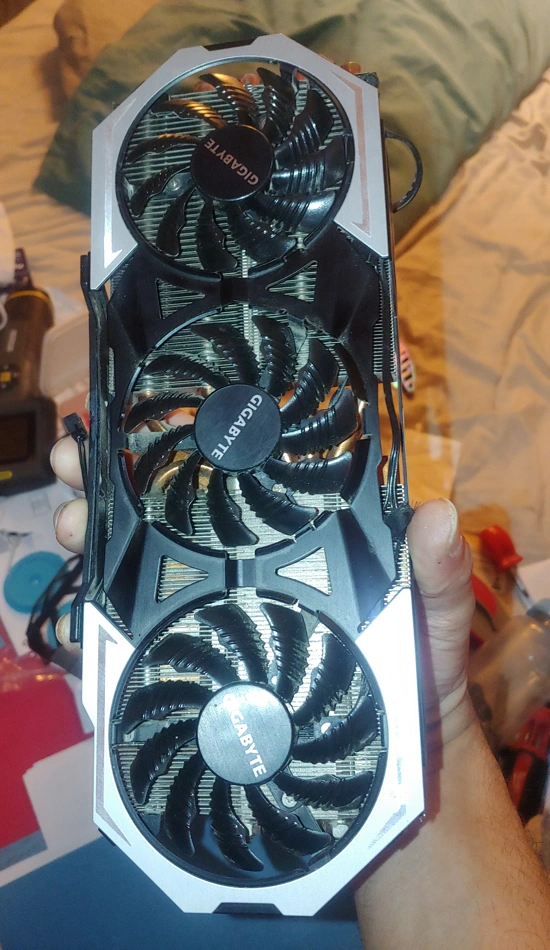
Table of Contents
Introduction
I plan to see if I can Fix a Burned out Nvidia Graphics Card, hopefully with some luck I’ll be able to pull my old graphics card back from the brink and you’re invited for the trip! Long story short I didn’t reboot after a driver update 3 weeks ago. I left my pc on standby instead of cycling power, when I went to fire up iRacing I got a strange 3d error and my computer died completely refusing to even boot.
In this first post I’ll outline troubleshooting which component failed on the graphics card, identifying the manufacturer and ordering an identical replacement part, or alternatively identifying a drop-in alternative component.
Background
Back in the bad old days near the height of the pandemic I decided to buy myself a gaming pc and take up sim racing again. The good news is that iRacing is capable of running on some seriously old hardware. Seriously the minimum specs are insanely low.
IRacing minimum system requirements
- CPU: 4 core CPU or better – AMD FX-6300, Intel Core i5-4430, Intel Core i5-2320, AMD Ryzen 3 1200
- RAM: 16 GB
- VIDEO CARD: A gaming graphics card with at least 2GB of DEDICATED memory Nvidia GeForce GTX 660 / GTX 1050 or ATI Radeon HD 7850 / AMD RX 550 or better
- DEDICATED VIDEO RAM: 2 GB
- PIXEL SHADER: 5.0
- VERTEX SHADER: 5.0
- OS: Windows 10 64-bit \ Windows 11 64-bit or better
- FREE DISK SPACE: 25 GB (50 GB for all the cars and tracks)
- SOUND CARD: Yes
My PC’s Specs:
- 850W PSU
- CPU: 8 core Intel i7-6700k
- RAM: 16 GB
- VIDEO CARD: Nvidia GTX 960
- DEDICATED VIDEO RAM: 6 GB
- FREE DISK SPACE: 500GB SSD
- SOUND CARD: Onboard Realtek 7.1 Dolby.
I paid $500 for the computer and at the time I was thrilled with the purchase then and haven’t regretted it since. My problem as you could probably guess was with that bottleneck of a video card. If I wanted to run triple monitors that card would do it in theory, — actually it’s doing it right now! — with all of the graphics at their lowest settings, and make sure you disable the Nvidia sound output too!
I didn’t realize that after I reinstalled this card it defaulted to providing sound through the HDMI. I couldn’t browse the web let alone launch a game with this thing freezing, and stuttering, every time a sound was played. It was plain unusable.
First Resurrection
This actually isn’t the first time I have Fixed this Burned out Nvidia Graphics Card. Though calling it burned out in the beginning would be a bit of a stretch.
Anyway, I rolled the dice and bought an Nvidia 980ti off of Ebay that was semi-functional. The ad said it worked but was loud, and very slow with screen freezes and such. I paid just under $350 for it. Ouch! — At the time it wasn’t bad a working 1070 was over $1200 and the 1080’s started in the $1500-$1800 — I wagered I knew what was wrong and it’d be an easy fix.
When I received the card, plugged it in and I knew immediately what was wrong. All 3 of the fans were shot, only 1 rotated and it was striking the heatsink every rotation making a racket. Amazon had my replacement fans in my hand the next day for around $20 and what-do-you-know? The thing worked beautifully!
Why was the card originally slow and noisy?
What was happening was that with no or very little airflow over the heatsink the card would fire up and work for a short amount of time. Specifically, it would work as normal up until the GPU hits it’s thermal limit. Any reasonably modern graphics card or processor should have a thermal sensor of some type — either a thermistor, thermocouple or another sensor — that will be tripped when the CPU, GPU, and on some boards even the chipset, exceeds a predetermined maximum safe operating temperature.
Upon reaching this limit, the system will cut the amount of voltage and current that it will send to the system as a whole, — this is known as “throttling” — or it may cut power and shut the system down all together. Which happens depends upon the drivers, bios settings, and/or chipset in use. This is to prevent you from burning out the chip and doing irreparable damage in the process. This system should prevent you from having to Fix a Burned out Nvidia Graphics Card, in the first place.
I feel I have to take a moment to say that even in this day and age you should never rely on such things to protect your hardware. If you know your system is running anywhere close to a thermal limit you should immediately stop any compute heavy tasks and troubleshoot the issue immediately. These things are meant as a last line of protection before irreparable damage occurs. They are intentionally set right at that limit, so they don't accidently trip while gaming or editing video, etc.
That said, in theory so long as you weren’t doing something like overclocking the card, where you specifically disable any thermal protection system, and assuming it activates in time it should be undamaged. — If you were doing something like overclocking then there is all likelihood no way to Fix a Burned out Nvidia Graphics Card, because in that case the GPU is probably toast. — Once it’s been tripped you should be able to basically limp along with say 1/4 the performance potential for as long as it takes to either cool back down to a safe range or for you to restart (cycle power) your PC.
For a non-gamer with a card as powerful as the 980ti that may be a perfectly acceptable level of performance. I’d wager if it weren’t for the noise and pandemic inflated prices the previous owner may have never sold this card.
Examination
Here are some pictures I snapped of my graphics card sans heatsink.
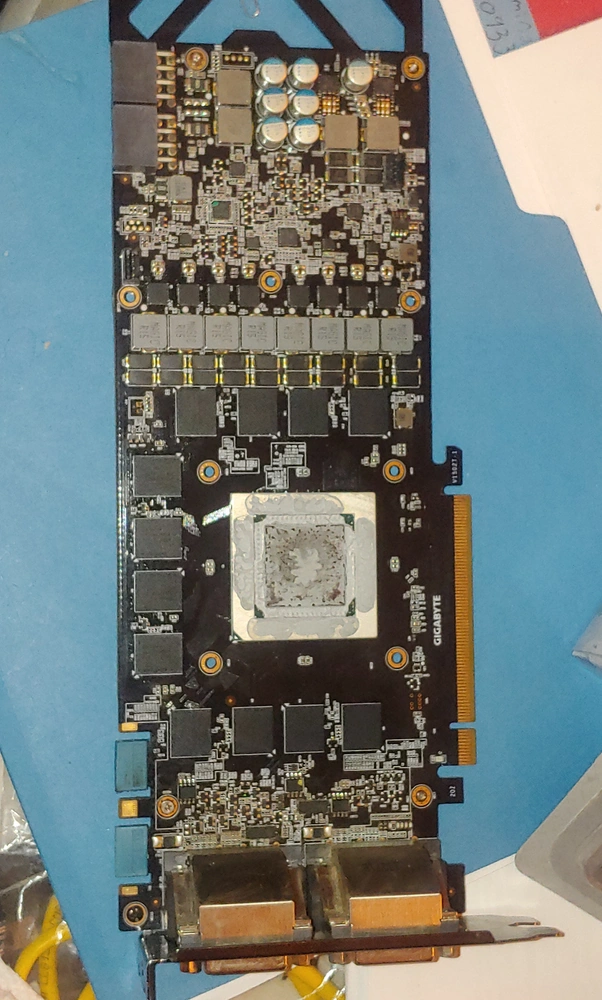
Pretty standard fare. One thing I noticed was that the sticker on my card says it has 8GB of onboard RAM. It has never displayed more than 6GB so a bit of a mystery there? The grey stuff on the GPU in the center of the image is just thermal compound. That’s completely normal and nothing to worry about. I will clean that off and apply some fresh compound when/if I get this thing repaired and try to run it.
Upon very close examination the culprit became obvious. It’s the chip that looks like it has been shot with a bb gun. The wrinkly look kind of burned look on some of the other chips aren’t actually there. They are artifacts because I was using a microscope app on my phone to examine the components closely. It’s not intended for capturing images because a phone camera isn’t intended to be used this way so it’s constantly struggling to keep focus on at least part of the visible area. My shaky hands don’t help either.
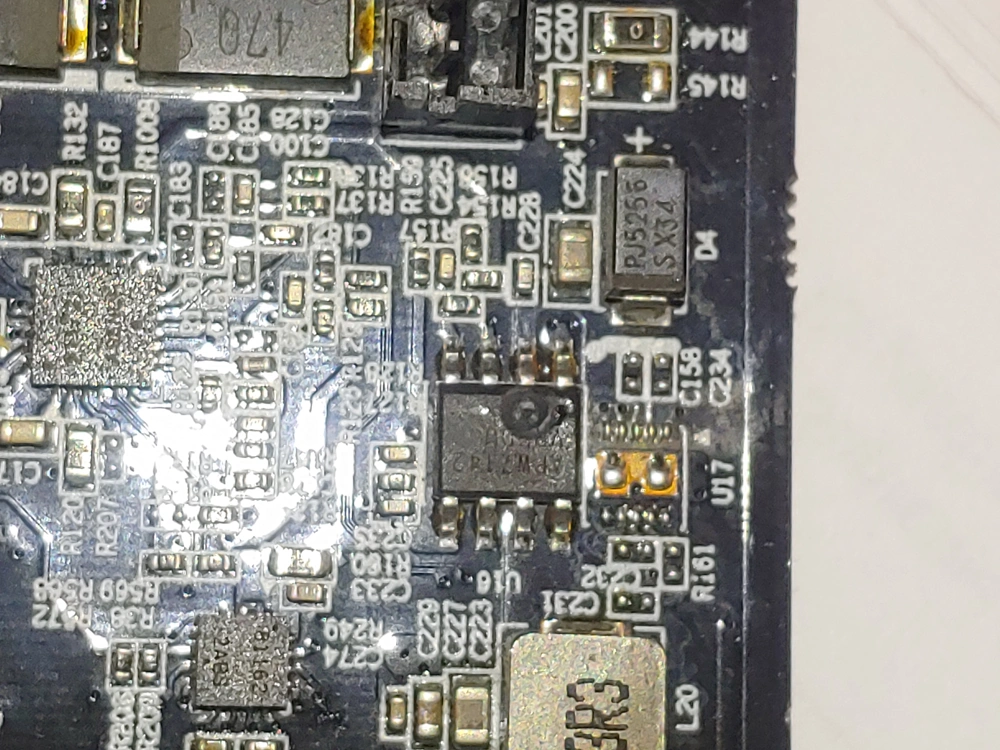
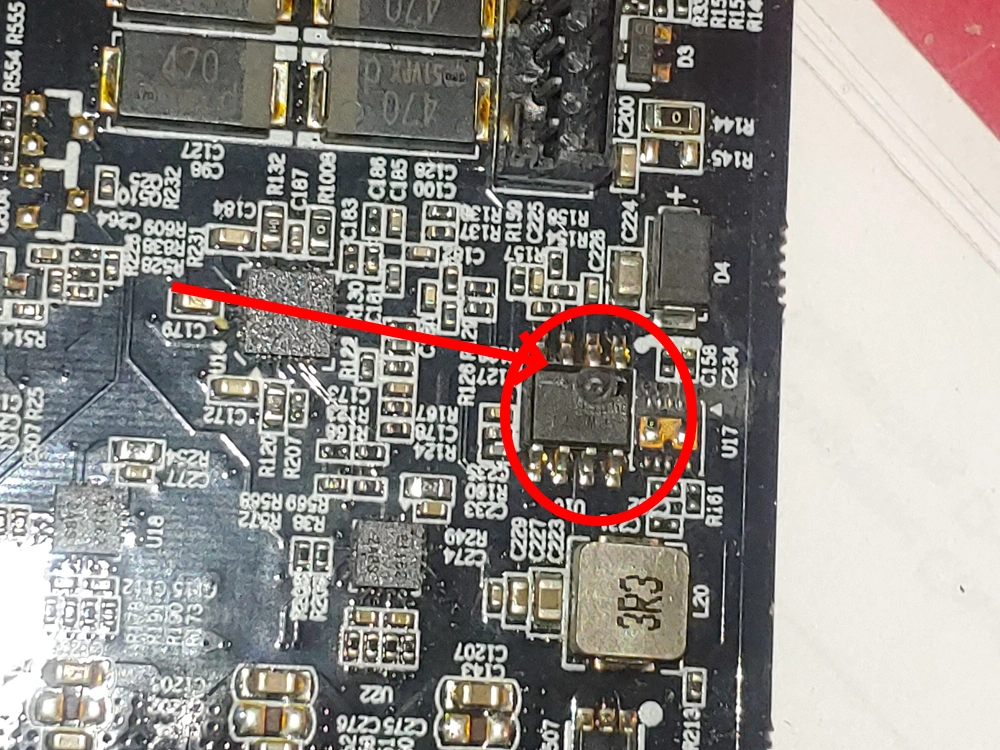
The burned-out component is a model #APW7142 3A 12V Synchronous-Rectified Buck Converter. It’s made by a company called ANPEC out of China and I can buy a 5 pack of them from Ebay for a little less than $7. You can find the datasheet for the APW7142 here.
Unforeseen Problem
I’d like to get a look at the bottom of this card to make sure there are no burned-out components on the underside. There is a shield covering the bottom the protect it from making contact with anything and I lack the proper tool to remove it.
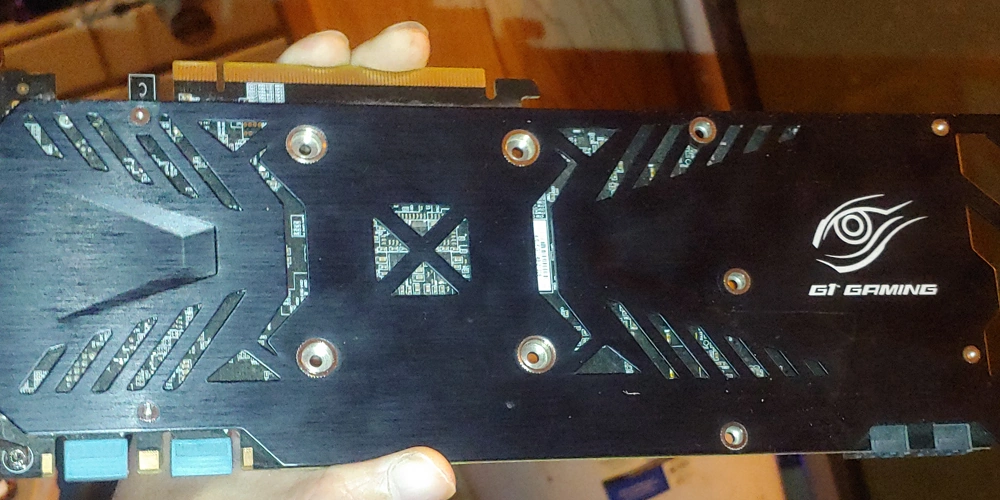
I’ve already ordered Buck-Converters and they come in a 5 pack, so I will probably just replace that one, and if it immediately burns out the replacement then I can be pretty sure there is something shorting out on the underside of the card. That is rolling the dice a little bit with my motherboard, that’s why when I first test it, I’ll use the old PC I have in my living room which serves as the family’s media center.
Conclusion thus far
I’m 90% sure replacing that single component will bring this Graphics card back to life. As soon as the component comes in from China, I will post an update to my progress as I attempt to Fix a Burned out Nvidia Graphics Card.
Related
If you are planning a project which will require a microcontroller here is a table with specs for the popular ones you can sort and compare, you can find our in-depth write-up for each microcontroller board featured in the table here, if you’re interested in a particular one which hasn’t been featured yet feel free to drop a comment or check back frequently as the table and writeups are being added to several times a week.
